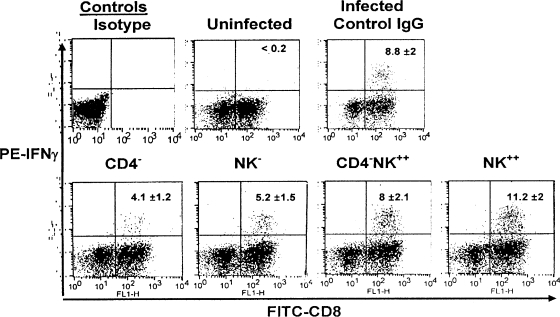FIG. 4.
NK cells affect CD8+ T-cell IFN-γ production, but addition can compensate for the loss of CD4+ T-cell help. C57BL/6 mice with HSV memory were divided into five groups: (i) depleted of NK cells (NK−), (ii) depleted of CD4+ T cells (CD4−), (iii) depleted of CD4+ T cells but supplemented with NK (CD4− NK++), (iv) supplemented with NK cells (NK++), and (v) receiving control IgG. All the mice were given 1 × 105 PFU of HSV and 5 days later were analyzed for IFN-γ production by CD8+ T cells to measure recall responses. The patterns were similar in all three experiments. A representative plot of intracellular IFN-γ staining in peptide-stimulated CD8+ T cells is shown. The data represents one mouse from each of the following groups: uninfected control, control IgG, CD4−, NK−, CD4− NK++, and NK++. The number within the plot is the mean ± SD for five mice in each group. The differences between the NK++ group and the CD4− and NK− groups were statistically significant (P < 0.005). The difference between the NK++ and CD4− NK++ groups was significant (P < 0.01).

